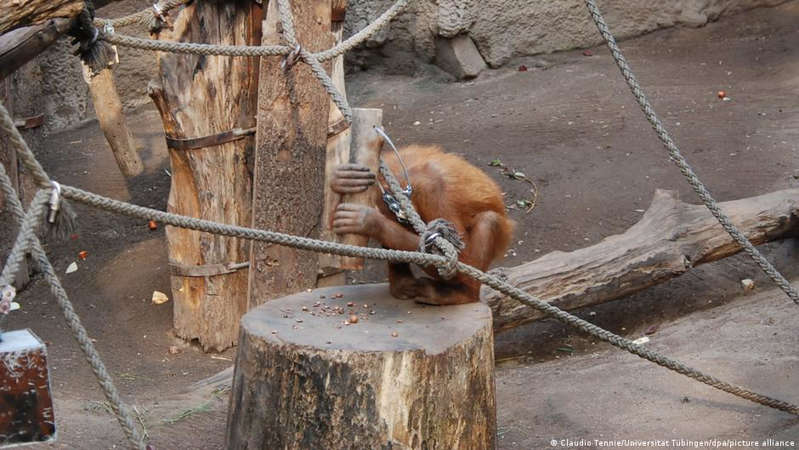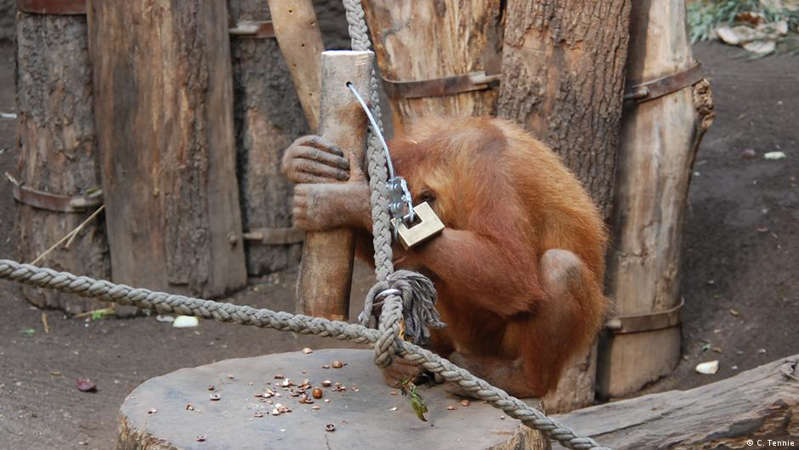Orangutans can crack nuts with a hammer. They acquire this skill spontaneously and on their own, without the need for anyone's care.

Provided by Deutsche Welle
Orangutans are quite capable of spontaneously acquiring new skills: for example, independently learning how to crack nuts with a hammer. However, they do not need any outside help. This is the conclusion reached by a research team led by Claudio Tennie from the University of Tübingen, which conducted scientific experiments with four orangutans at the Leipzig Zoo. The research results are published in the prestigious American scientific research publication American Journal of Primatology.
Researchers have refuted the well-established scientific opinion that certain skills in great apes can disappear if they are not transmitted through cultural transmission – from one individual to another, from previous generations to the next. Now scientists will have to reconsider their views and conclusions on this issue.
“It turned out that cracking nuts with tools (at least in the case of orangutans) does not require cultural transmission through peeping, copying from other animals and transferring these skills to subsequent generations,” – said in an interview with DW, study leader, Ph.D. Claudio Tenney.
The essence and conditions of the experiment with monkeys
Biological scientist Claudio Tenney told DW that during the study, orangutans at the Leipzig Zoo were offered hard nuts, and tree branches and sticks as handy tools for cracking them. “The orangutans used the proposed blocks to crack the nuts spontaneously, no one had ever taught them this before,” the project manager emphasizes.

Biological scientist from Tübingen Claudio Tenney
Moreover, according to him, orangutans after chimpanzees are the second monkeys who choose the right tools for certain jobs. Scientists have not yet observed how wild animals crack nuts. At the same time, the biologist emphasizes that the zoo staff have never shown orangutans how to crack nuts before. “This was the main condition of our experiment,” – emphasizes in an interview with DW Claudio Tenney.
In the study, one of the orangutans first used the bar as a hammer, and in later experiments, the bar was so firmly attached to the place it was lying on that the orangutan could not use it. In response, the animal took a hammer-like wooden object in its hands to crack a nut. According to the scientist, three elderly orangutans tried to crack their nuts with their hands and teeth. They could not do it with their hands, but with their teeth, three of the four orangutans were able to cope with this task without any problems.
New study confirms results from 40 years ago
Scientists were able to confirm the theses from the thesis of almost 40 years ago, then a student from Zurich Martina Funk (Martina Funk). When the Tubingen researchers sent the manuscript of their study to the American Journal of Primatology, an editorial staff member advised them to track down the author of an unpublished thesis on the same topic in order to back up the results of the long-standing experiment with new findings.

A participant in an experiment at the Leipzig zoo splits nuts with a wooden block
“To our great joy, we were able to find a thesis and its author – Martina Funk, who actually conducted the same experiments with orangutans at the Zurich Zoo between 1983 and 1984. Zurich monkeys, like the Leipzig monkeys, spontaneously and independently, independently of each other. friend, learned how to crack nuts with hard objects, like hammers, “sums up Claudio Tenney. Of course, the Swiss biologist co-authored a new scientific publication that refutes some, but fundamentally important, well-established conclusions of scientists who have studied great apes in the past.
So, the main conclusion: orangutans can not only maintain behavioral skills, but also independently and independently of each other acquire new ones. “This is a fundamental question for scientists studying the problems of the evolution of the animal world,” – emphasizes the biologist from Tubingen Claudio Tenney.
See also:
Author: Victor Weitz

